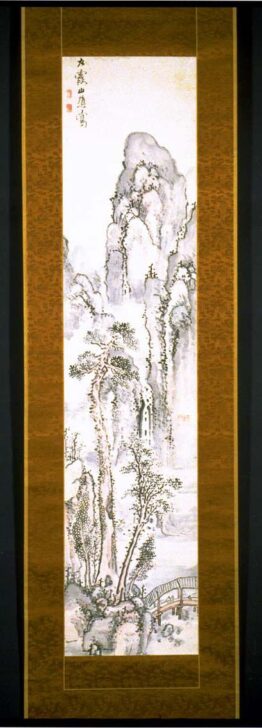Mountain Landscape
Ikeno Taiga; Ikeno Gyokuran

Description
Ike Taiga was one of the towering figures in Kyoto painting of the mid-eighteenth century. A child prodigy at calligraphy, he learned Chinese poetry and philosophy through his friendships with Confucian scholars and the Ôbaku Zen monks of Manpukuji. Since Chinese literati paintings were then still scarce in Japan, his models were taken from woodblock printed books. James Cahill has argued that Taiga’s “pointillist” style, which separates brushstrokes into distinct units with little use of wash, probably derives from the technical limitations of his printed sources.
For Taiga and his contemporary, Yosa Buson, Chinese literati painting provided fresh inspiration and a validation of a certain lifestyle—one devoted to the study of letters and the cultivation the mind. Taiga fit to a “T” the ideal of the untrammeled spirit: he was careless about money, often almost slovenly in appearance, and frequently tipsy—but also generous, entertaining, and a brilliant artist.Maribeth Graybill, for the exhibition "Japanese Visions of China," 9/21/02 - 1/26/03
Subject Matter:
Taiga's sense of joy in nature is evident in this lightly colored landscape which features figures standing on a covered bridge enjoying the distant waterfall.
"Most of Taiga's landscapes were executed quickly on paper in sumi ink strokes, with only a few colors. Western pointillist-painters labored slowly on linen canvases, building up squares or"points" of oil pigments on top of each other, covering up any mistakes by adding another"point" of color. Compared with the solidity of a Seurat or Signac work, a Taiga landscape seems much lighter and more natural in feeling. He was able to add variety to his landscapes by combining the "points" he used for foliage with a contrasting brush-line for tree trunks."
Covell, Jon Etta Hastings Carter. Japanese Landscape Painting. Crown Publishers, 1962.
Physical Description:
This lightly colored landscape features figures standing on a covered bridge enjoying the distant waterfall. To the left of the painting, there are trees with rocks scattered around on the ground. In the distance, there are mountains that contain a little greenery. The waterfall comes out of these mountains and empties into a river; mist formes from this. In the top left corner of the painting, there is a signature.
Usage Rights:
If you are interested in using an image for a publication, please visit https://umma.umich.edu/request-image/ for more information and to fill out the online Image Rights and Reproductions Request Form.